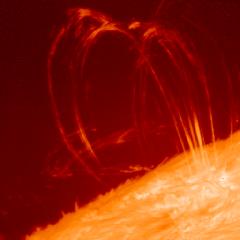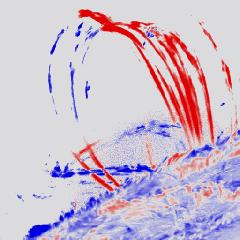 |
|
+ Home | ||

|
||||
| + Solar Cycle Prediction | + Magnetograph | + The Sun in Time | + The Hinode Mission | + The STEREO Mission |
Post-Flare Loops
|
In the hours following a solar flare we often see a series of loops above the surface of the Sun. These loops are best seen when viewed in the light emitted by hydrogen in the red region of the solar spectrum (H-alpha emission). The loops shown to the left formed after an active region (AR 7205) flared on June 26, 1992. Time-lapse movies (3.5 MB Quicktime movie or 1.3 MB MPEG movie) show how material "condenses" out of the Sun's hot corona in tops of these loops and then flows down the legs of the loops onto the surface. Within the magnetic confines of these loops the material is somewhat isolated from the million degree corona and can cool to much lower temperatures. These particular loops are of interest because they include a set of "bent-over" loops that figure prominently in theoretical models for some flares. | ||
|
The velocity of the material flowing in these loops can be determined using the "Doppler effect." The light from material moving toward us is shifted toward the blue end of the spectrum while light from material moving away from us is shifted toward the red end. The image at the left shows the Doppler shift of the H-alpha emission. This information can be used with the observed motion of the material (3.5 MB Quicktime movie or 2.4 MB MPEG movie) to determine the three-dimensional flow of material within these loops. We find that the loops form an arcade, a series placed one after another to form a tunnel-like structure. The "bent-over" loop threads through the arcade with footpoints on opposite sides on the opposite ends. These observations were obtained with the Swedish Solar Telescope on LaPalma in the Canary Islands by T. Tarbell (Lockheed/Palo Alto) and the data was provided through B. Schmieder (Observatoire de Paris, Meudon). The scientific results can be found in a paper by Moore, Schmieder, Hathaway, and Tarbell, Solar Physics 176, pp 153-169 (1997). |

